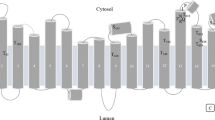Abstract
Vacuolar proton pumping pyrophosphatase (H+-PPase; EC 3.6.1.1) plays a pivotal role in electrogenic translocation of protons from cytosol to the vacuolar lumen at the expense of PPi hydrolysis. A histidine-specific modifier, diethylpyrocarbonate (DEPC), could substantially inhibit enzymic activity and H+-translocation of vacuolar H+-PPase in a concentration-dependent manner. Absorbance of vacuolar H+-PPase at 240 nm was increased upon incubation with DEPC, demonstrating that an N-carbethoxyhistidine moiety was probably formed. On the other hand, hydroxylamine, a reagent that can deacylate N-carbethoxyhistidine, could reverse the absorption change at 240 nm and partially restore PPi hydrolysis activity as well. The pK a of modified residues of the enzyme was determined to be 6.4, a value close to that of histidine. Thus, we speculate that inhibition of vacuolar H+-PPase by DEPC possibly could be attributed to the modification of histidyl residues on the enzyme. Furthermore, inhibition of vacuolar H+-PPase by DEPC follows pseudo-first-order rate kinetics. A reaction order of 0.85 was calculated from a double logarithmic plot of the apparent reaction constant against DEPC concentration, suggesting that the modification of one single histidine residue on the enzyme suffices to inhibit vacuolar H+-PPase. Inhibition of vacuolar H+-PPase by DEPC changes V max but not K m values. Moreover, DEPC inhibition of vacuolar H+-PPase could be substantially protected against by its physiological substrate, Mg2+-PPi. These results indicated that DEPC specifically competes with the substrate at the active site and the DEPC-labeled histidine residue might locate in or near the catalytic domain of the enzyme. Besides, pretreatment of the enzyme with N-ethylmaleimide decreased the degree of subsequent labeling of H+-PPase by DEPC. Taken together, we suggest that vacuolar H+-PPase likely contains a substrate-protectable histidine residue contributing to the inhibition of its activity by DEPC, and this histidine residue may located in a domain sensitive to the modification of Cys-629 by NEM.
Similar content being viewed by others
REFERENCES
Britten, C. J., Turner, J. C., and Rea, R. A. (1989). FEBS Lett. 256, 200-206.
Cousineau, J. and Meighen, E. (1976). Biochemistry 15, 4992-5000.
Fiske, C. H. and Subbarow, Y. (1925). J. Biol. Chem. 66, 378-400.
Hung, S. H., Chiu, S. J., Lin, L. Y., and Pan, R. L. (1995). Plant Physiol. 109, 1125-1127.
Kim, E. J., Zhen, R. G., and Rea, P. A. (1995). J. Biol. Chem. 270, 2630-2635.
Kim, Y., Kim, E. J., and Rea, P. A. (1994). Plant Physiol. 106, 375-382.
Kuo, S. Y. and Pan, R. L. (1990). Plant Physiol. 93, 1128-1133.
Larson, E., Howlett, B., and Jagendorf, A. T. (1986). Anal. Biochem. 155, 243-248.
Levy, H. M., Leber, P. D., and Ryan, E. M. (1963). J. Biol. Chem. 238, 3654-3659.
Maeshima, M. (2000). Biochim. Biophys. Acta 1465, 37-51.
Marchesini, N. L., Luo, S., Rodrigues, C. O., Moreno, S. N., and Docampo, R. (2000). Biochem. J. 347, 243-253.
Maeshima, M. and Yoshida, S. (1989). J. Biol. Chem. 264, 20068-20073.
Miles, E. W. (1977). Meth. Enzymol. 47, 431-442.
Nelson, N., Perzov, N., Cohen, A., Hagai, K., Padler, V., and Nelson, H. (2000). J. Exp. Biol. 203, 89-95.
Rakitzis, E. T. (1984). Biochem. J. 217, 341-351.
Sakakibara, Y., Kobayashi, H., and Kasamo, K. (1996). Plant Mol. Biol. 31, 1029-1038.
Sarafian, V. and Poole, R. J. (1989). Plant Physiol. 91, 34-38.
Sarafian, V., Potier, M., and Poole, R. J. (1992). Biochem. J. 283, 493-497.
Tanaka, Y., Chiba, K., Maeda, M., and Maeshima, M. (1993). Biochem. Biophy. Res. Comm. 181, 962-967.
Tzeng, C. M., Yang, C. Y., Yang, S. J., Jiang, S. S., Kuo, S. Y., Hung, S. S., Ma, J. T., and Pan, R. L. (1996). Biochem. J. 316, 143-147.
Wang, M. Y., Lin, Y. H., Chow, W. M., Chung, T. P., and Pan, R. L. (1989). Plant Physiol. 90, 475-481.
Yang, S. J., Jiang, S. S., Tzeng, C. M., Kuo, S. Y., Hung, S. H., and Pan, R. L. (1996). Biochim. Biophys. Acta 1294, 89-97.
Yang, S. J., Jiang, S. S., Kuo, S. Y., Hung, S. S., Tam, M. F., and Pan, R. L. (1999). Biochem. J. 342, 641-646.
Yang, S. S., Ko, S. S., Tsai, Y. R., Yang, S. J., Jiang S. S., Kuo, S. Y., Hung, S. H., and Pan, R. L. (1998). Biochem. J. 331, 395-402.
Zhen, R-G., Kim, E. J., and Rea, P. A. (1994). J. Biol. Chem. 269, 23342-23350.
Author information
Authors and Affiliations
Corresponding author
Rights and permissions
About this article
Cite this article
Hsiao, Y.Y., Van, R.C., Hung, H.H. et al. Diethylpyrocarbonate Inhibition of Vacuolar H+-Pyrophosphatase Possibly Involves a Histidine Residue. J Protein Chem 21, 51–58 (2002). https://doi.org/10.1023/A:1014183100021
Published:
Issue Date:
DOI: https://doi.org/10.1023/A:1014183100021




